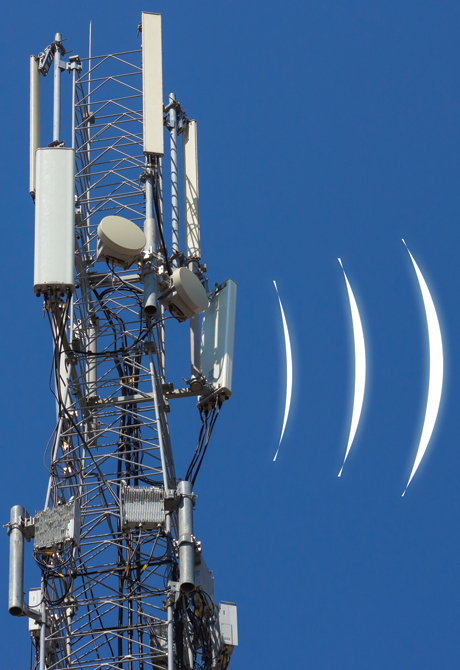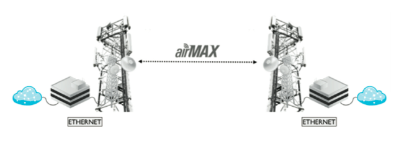A wireless transceiver device is typically mounted at each location and communicate wirelessly only with each other in order to send/receive data. This data is then passed to a wired connection that is integrated into both devices. Multiple pairs of PTP devices can be daisy chained in order to overcome issues, such as larger distances or unfavourable conditions, as illustrated in the image below. These solutions are typically used as an alternative to the substantially high cost ADSL/fibre solutions, slower/unstable VPN tunnels over existing connections, or where terrain does not allow for cable to be laid into the ground.
Distance
PtP distances can reach anywhere up to 300KM, depending on terrain, environment, which frequency a PTP radio operates in, how large the antennas are, and what vendor is being used.
If you are opting for a large range, you may need to take into consideration the Earth’s surface and curvature, and therefore create more height to allow for this. In addition, weather conditions as well as possible neighbouring / clashing frequencies will need to be taken into account.


Throughput Requirements
Typically, PtP bridges can use almost any frequency. These include, but are not limited to: 2.4GHz, 5GHz, 24Ghz, 60GHz, 80GHz. Higher frequencies usually offer more throughput, but typically trade-off range as a result.
As an alternative to radio Point-to-Point links, there is also the option of Free Space Optics / Laser Links. How do you know which one will be best suited for your needs?
If you live in a rural area, with barely any interference, you may wish to utilise the 2.4GHz frequency due to its range and resilience, however, if you’re a small business or home user with higher bandwidth requirements, it’s likely you’ll want to use 5GHz (unless you’re in a very busy area, such as a city centre or highly/densely populated area, where the 5Ghz band is congested). Alternatively, if you have a link over 1km or so that is crucial to your business, then 60GHz and microwave technology will be best suited for your needs.
Frequency Guidelines:
- 2.4GHz max speeds: ~170Mbps (15km max)
- 5GHz max speeds: 700+Mbps (12km max)
- 24Ghz max Speeds: 2Gbps (5km max)
- 60GHz max speeds: 5Gbps (1.5Km max)
- Laser max speeds: 10+Gbps (350m max)
Antenna design: Connectorised/Integrated/Both
Some devices allow for antenna customisation, which can provide better results, but requires configuration based on local output restrictions to ensure you do not exceed the signal strengths allowed in your country. The below options are typically available for different radios:
Connectorised: These have an external antenna connection. There is not built-in antenna and if the antenna is not supplied with the radio, may need to be purchased separately. The advantage of this is that if you have a long range link or have issues with external interference, you have the flexibility to use external antennas that are able to concentrate the signal in the required direction and reject interference. By the same principle, you could opt for an antenna that provides short range coverage, using the same radio.
Integrated: These devices have a built in antenna. This is suited to those who have a straightforward link, and requires a quick and easy set up. Since the antenna is made and integrated into the device by the manufacturer, there is a greater degree of control and lower short term risks associated with these devices. The downside is that the same radio may not be re-purposed or a link that has a different range/coverage requirement.
Both: Has a built in antenna and has the ability to add external antennas to boost signal strength and reliability. This can provide the best of both worlds, but are usually more expensive.



